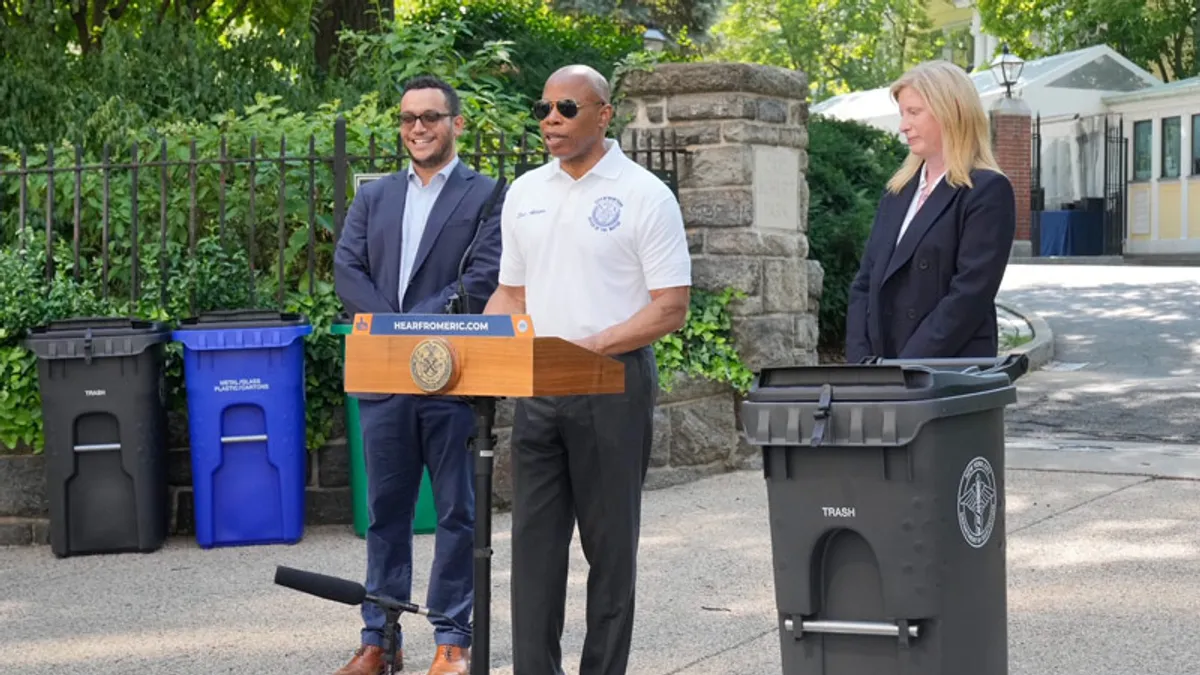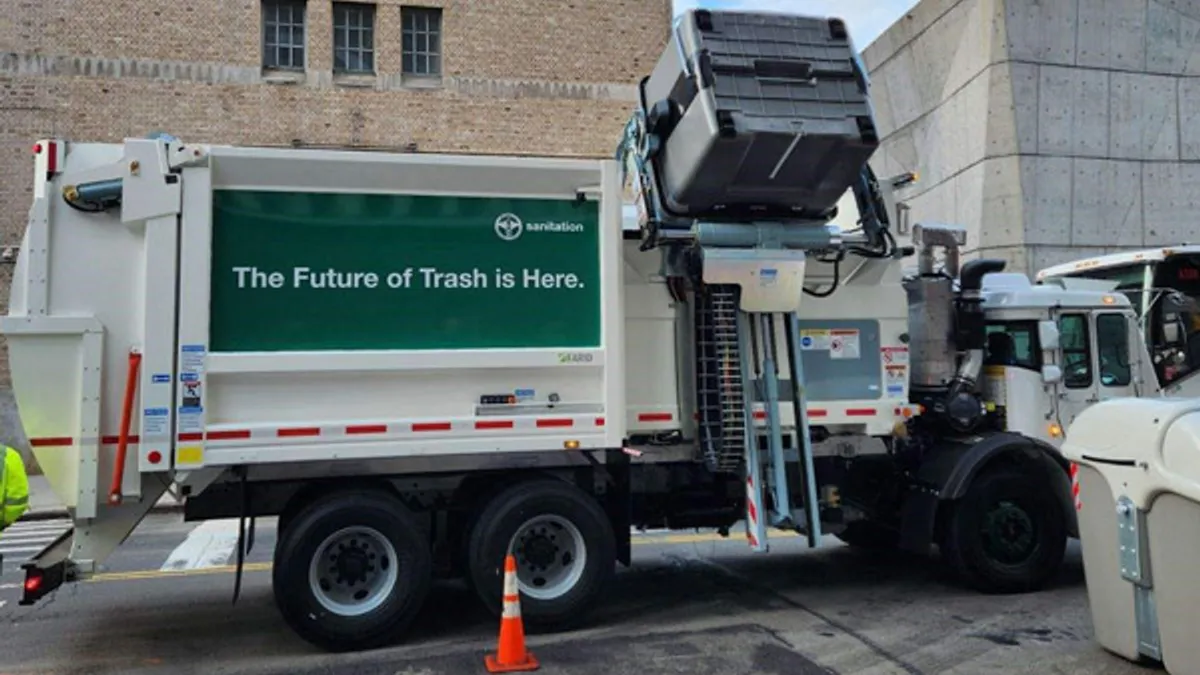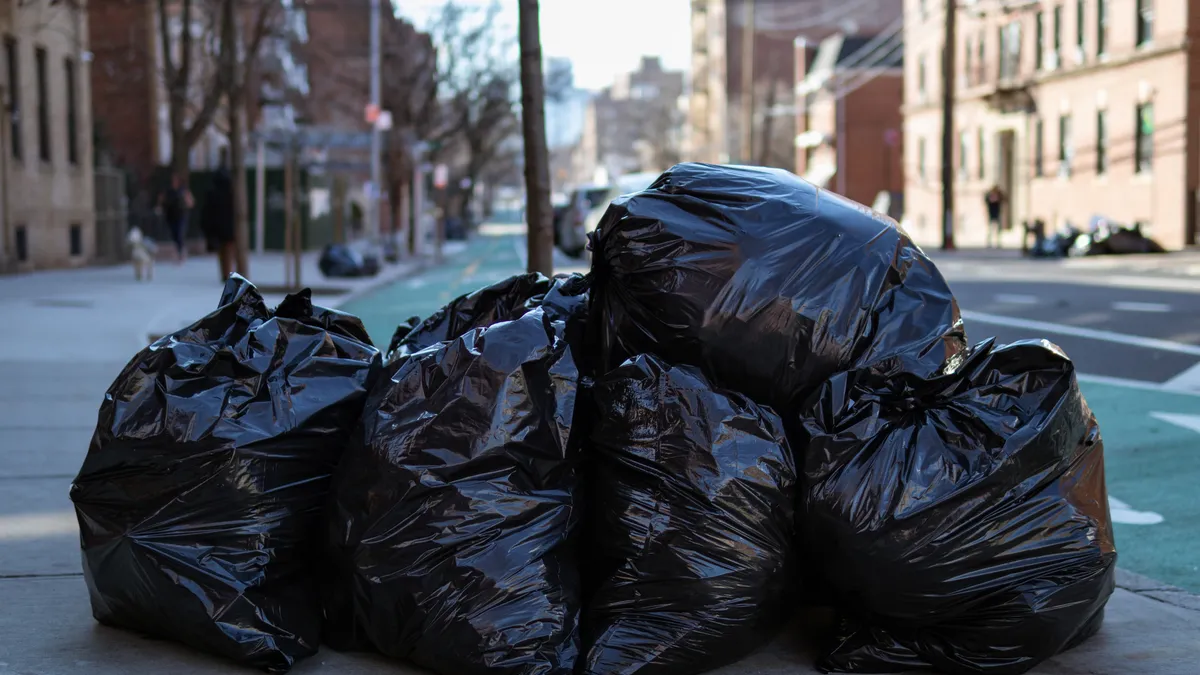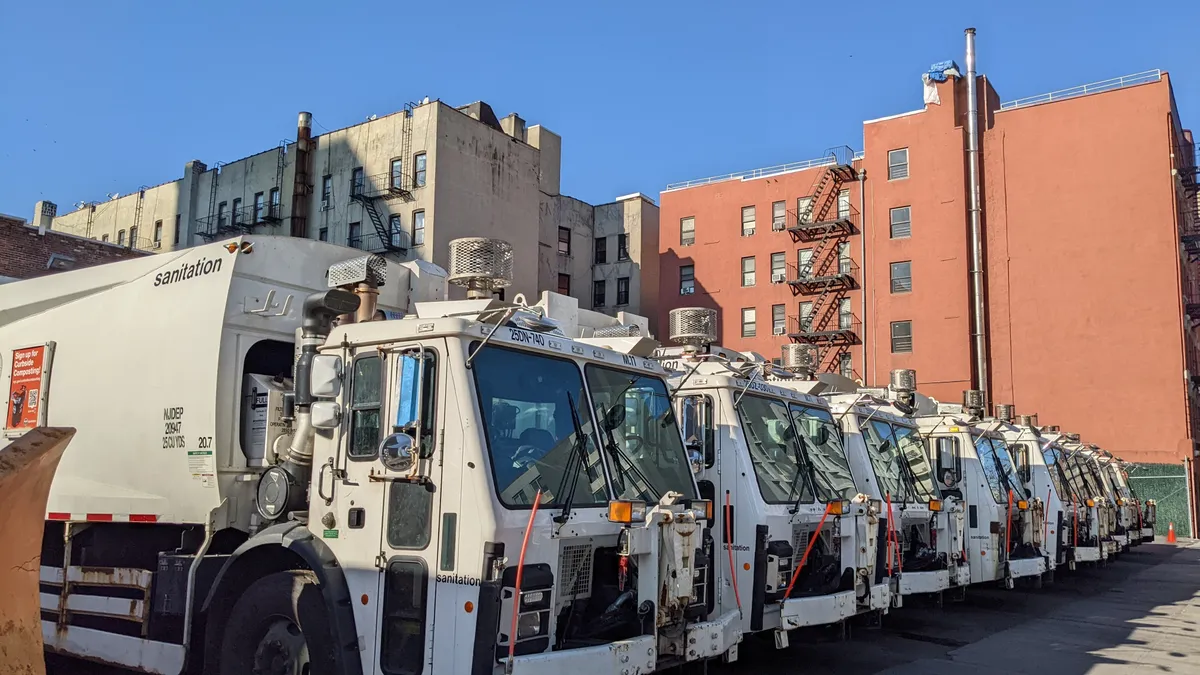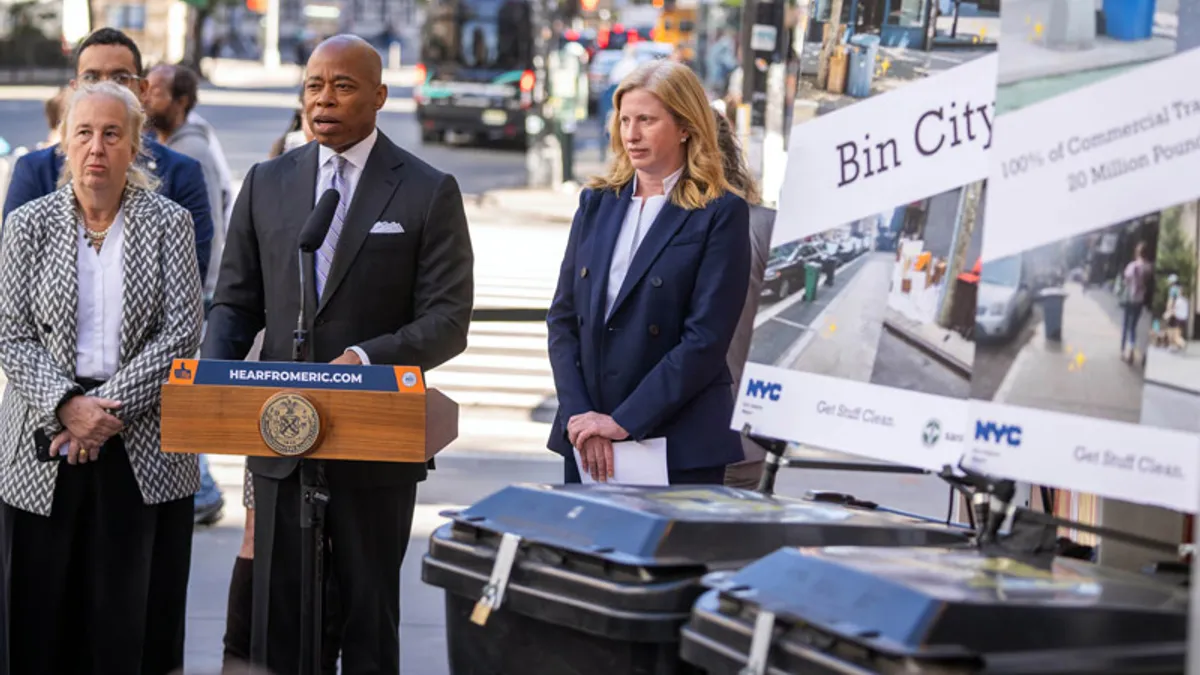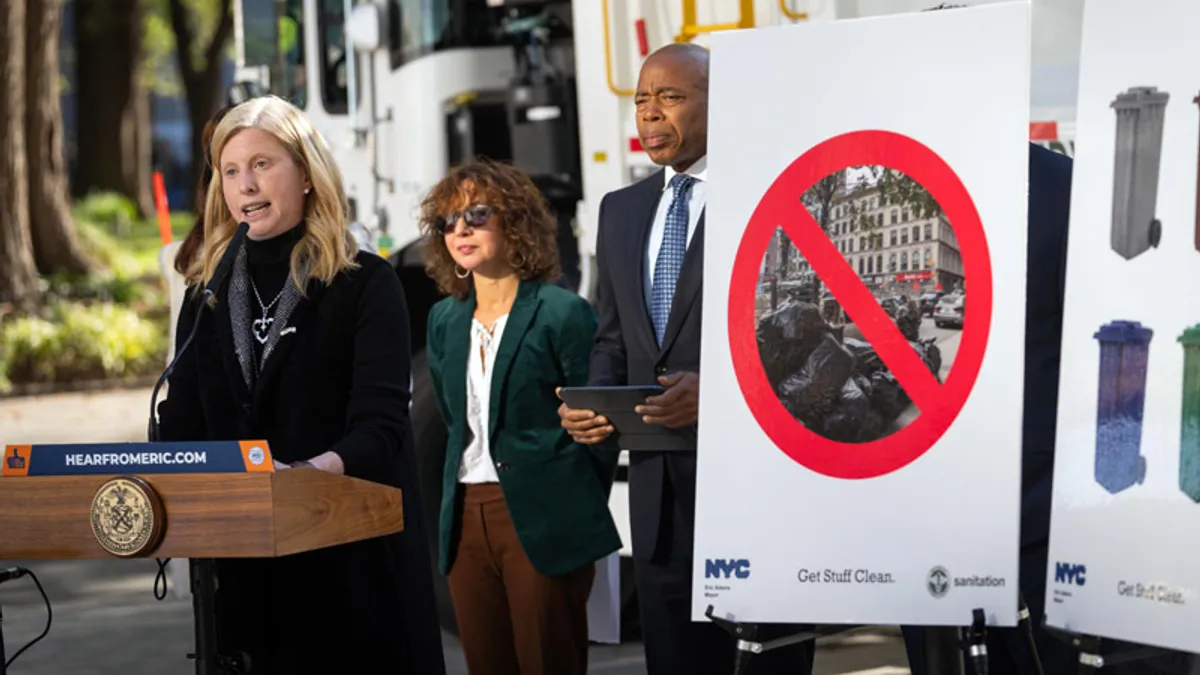UPDATE: July 9, 2024: Mayor Eric Adams rolled out a demonstration NYC Bin on Monday and the city’s Department of Sanitation proposed a rule requiring owners of buildings with one to nine units to have lidded bins by Nov. 12. Those who already have bins with latching lids that are 55 gallons or less do not need to replace their bins with the official city bin, provided by Otto, until June 1, 2026. The rule would also apply to special use buildings that receive DSNY collection, such as those used by city agencies or houses of worship.
Dive Brief:
- March 25: New York City's Department of Sanitation plans to award Otto Environmental Systems a 10-year contract, with two optional five-year renewals, as the exclusive provider of refuse, recycling and organics bins for all residents in one-to-nine unit buildings. Buildings 10 to 30 units could also use the bins, according to the city's initial request for proposal.
- The contract licenses Otto to sell branded NYC Waste Bins to residents or building owners on behalf of DSNY and passes operational costs onto Otto. In its RFP, the agency set a maximum price for the bins based on the lower end of retail prices for bins in the area.
- DSNY plans to discuss the contract at a hearing on April 8. The agency is also expected to release a rule requiring building owners to acquire the bins soon.
Dive Insight:
New York Mayor Eric Adams’ administration has heavily pushed containerization to modernize the city’s waste system, but doing so has required navigating diverse residential building types and limited public space.
The city twice extended the deadline for companies to apply for the RFP and answered dozens of questions about the structure of the contract. Besides Otto, Wastequip, Rehrig-Pacific, Cascade Cart Solutions and others attended pre-bid sessions to discuss the RFP.
Travis Dowell, vice president of sales for Otto, said the company is “super pumped” to receive the contract and supply bins for the city.
“It's a huge win for DSNY and for Otto,” Dowell said. “It's very, very important for NYC that the residents of NYC will realize containerization like the rest of the country has, and also realize hopefully a rat-free city, which is the ultimate goal.”
Otto’s primary facilities are in Charlotte, North Carolina, and it operates seven manufacturing plants in total. Dowell said the bins would likely come from multiple plants, including another facility in South Bend, Indiana.
The rollout of the bins is subject to approval by DSNY, and Dowell declined to say whether the company would send bins to certain boroughs or neighborhoods first, as other DSNY initiatives have done.
The contract includes milestones by which Otto must provide a certain number of bins by certain dates, divided into bin type categories that include the metal, glass and plastics recycling stream.
| Bins delivered by: | Refuse | MGP | Paper | Organics | All streams |
|---|---|---|---|---|---|
| Nov. 1, 2024 | 750,000 | 80,000 | 80,000 | 50,000 | 960,000 |
| May 1, 2025 | 100,000 | 95,000 | 95,000 | 50,000 | 340,000 |
| Oct. 27, 2025 | 100,000 | 95,000 | 95,000 | 50,000 | 340,000 |
| May 1, 2026 | 200,000 | 600,000 | 600,000 | 350,000 | 1,750,000 |
| Subtotal | 1,150,000 | 870,000 | 870,000 | 500,000 | 3,390,000 |
The bins will initially come in three sizes: a 20 to 25 gallons size for organics, a 30 to 35 gallons size used in certain places for refuse and recycling and a 45 to 50 gallons size which will be the dominant size for non-organic material streams. DSNY also retained the option to require Otto to make a 60 to 65 gallons “oversized bin” available for purchase at its discretion.
| Bin size | Price |
|---|---|
| 20 to 25 | $43.47 |
| 30 to 35 | $45.88 |
| 45 to 50 | $53.01 |
| 60 to 65 | $60.08 |
Over the first two years of the contract, Otto is expected to provide weekly reports to DSNY about its progress distributing the bins. Once the initial bin distribution period expires, it’s expected to provide monthly reports.
Otto is also expected to provide a website for New Yorkers to purchase the bins with translation into several languages. The contract encourages Otto to set up brick-and-mortar locations in all five boroughs, but does not require them to do so.
The agency has yet to promulgate a rule requiring small residential buildings to move to DSNY-approved bins for set outs, but the agency has still indicated such building owners will be required to do so by the summer of 2026. DSNY also recently began a containerization pilot in Manhattan that could expand, though that project has so far only applied to buildings with 31 or more units.
There are some early signs that the pilot is working in Northern Manhattan, New York City Council Member Shaun Abreu, who leads the council’s Sanitation and Solid Waste Management committee, said at a hearing in February. He noted calls to complain about rats were down by 68% after implementation.
In a statement on Friday, the council member said he would examine the details of the proposed contract with Otto in future committee hearings.
“Containerization is the gateway to a cleaner, rodent-free city. As sealed bins are rolled out citywide, I look forward to overseeing the contracting process and ensuring implementation proceeds in a sensible manner for our communities,” Abreu said.
At an October hearing, DSNY officials spoke about the RFP and their plans to respond to dozens of questions they received from interested parties. Francesca Haass, executive director of policy and planning for the agency, said then that the RFP was designed with manufacturing timelines in mind, and as such the agency based many of the features they’d require on the bins on features that already existed in products on the market.
“There are many products currently on the market that would work for New York City bins, I don't think we need some super special design,” Haass said.



